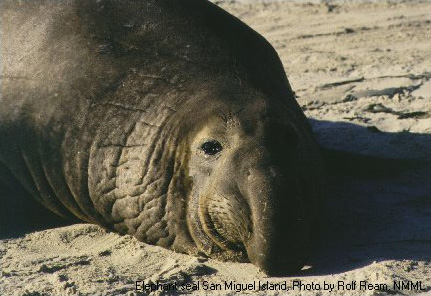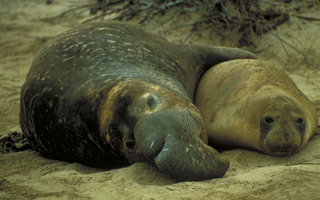Northern Elephant Seal
Common Name: Northern Elephant Seal
Scientific Name: Mirounga angustirostris
Meaning of Scientific Name: Having a Narrower Snout than the Southern Elephant Seal

History
Hundreds of thousands of northern elephant seals once inhabited the Pacific Ocean. They were slaughtered wholesale in the 1800s for the oil that could be rendered from their blubber. By 1892, only 50 to 100 individuals were left. The only remaining colony was on the Guadalupe Island off the coast of Baja California.
In 1922, the Mexican government gave protected status to elephant seals, and the U. S. government followed suit a few years later when the seals began to appear in Southern California waters. Since that time, elephant seals have continued to multiply exponentially, and they have extended their breeding range as far north as Point Reyes. Today, there are approximately 160,000 northern elephant seals.
The first elephant seals on Año Nuevo Island were sighted in 1955, and the first pup was born there in 1961. In 1978, 872 were born there. Males began to haul out on the mainland in 1965. A pup born in January 1975 was the first known mainland birth of a northern elephant seal at Año Nuevo; 86 pups were born there in 1978. By 1988/1989, about 2,000 elephant seals came ashore at Año Nuevo, and the number of seals breeding and giving birth on the mainland is still increasing. During the 1994-95 breeding season, approximately 2,000 pups were born on the mainland.
Description
Northern elephant seals are in the family Phocidae. They have short, coarse grey or brown fur and a very thick blubber layer that insulates them from cold water.
Adult males are larger than females and can weigh up to 5,000 pounds. Females can weigh up to 1,700 pounds. Adult males have a 'chest shield' that develops with age to protect them from injury when they fight with other males for breeding territories. The chest shield is pink and is formed from keratinized skin. Males also develop a probosicis with age.
Once each year, northern elephant seals molt. An epidermal molt is a unique characteristic of elephant seals and monk seals. Once a year the animals come ashore and shed their fur and the first layer of skin (or epidermis). The skin and fur come off in sheets as new skin and fur replace old. When the molt is finished, the animals have silver fur. Between the molting and breeding seasons, northern elephant seals remain at sea for 6 to 8 months, traveling thousands of miles and spending 86% of their time submerged
Habitat and Range
Breeding colonies are found primarily along the California coast. In spring and summer seals also haul out at these areas for molting, as well as at some sites in Washington and British Columbia. Outside of the breeding and molting seasons, for roughly 8 to 10 months of the year, Northern Elephant Seals range widely to forage into the eastern and central North Pacific. Vagrant juveniles have been sighted as far away as Hawaii and Japan.
Feeding
They are nocturnal deep pelagic feeders. At sea, elephant seals typically dive 20 minutes to a depth of 1,000 to 2,000 feet in search of food: rays, skates, rat fish, squid, and small sharks, Octopus, hagfish. The maximum recorded depth is 5,015 feet by a male in 1991.
The females eat nothing while they are giving birth, nursing, and mating, and the males go without food for up to three months at that time. They are preyed upon by killer whales and sharks.
Behaviour
During the breeding and molt seasons Northern Elephant Seals may aggregate in groups of up to several hundred. When ashore to molt, they crowd together in dense groups and spend most of the time sleeping. The rest of the year they travel or forage at sea and are thought to be solitary.
Breeding Season
The elephant seal breeding season begins at Año Nuevo in December, when the first males arrive. From fourteen to sixteen feet long and weighing up to 2 1/2 tons, these huge bulls engage in violent battles to establish dominance. The successful bulls do much of the breeding, with most of the duty falling on the "alpha" bull at the top of the social ladder.
Birth
In late December, the females begin to arrive and form "harems" on the beaches of the Reserve. Much smaller than the males, they average ten to twelve feet in length and weigh 1,200 to 2,000 pounds. Three to six days after she arrives, the female gives birth to the pup that was conceived the previous year. Normally only one pup is born to each female, and she nurses for 25 to 28 days.
Nursing
Ordinarily, a mother nurses her own pup, although if they are separated another female may adopt the youngster. Feeding on its mother's rich milk (55% fat), the pup grows from approximately 75 pounds at birth to 250-350 pounds in less than a month. Some resourceful pups nurse from two or three females. They can weigh 600 pounds and are aptly called "super weaners".
Mating and Gestation

Females come into season and mate about 24 days after giving birth. However, the fertilized egg does not implant in the wall of her uterus for about four months a rare phenomenon called "delayed implantation". The theory is that the female is so weak after nursing and fasting that she doesn't have enough energy to nourish the egg. Since the seals' gestation period is seven months, this delay means that the young will be born after the female reaches her breeding ground the following year. The pups could not survive if born at sea. Adult females may mate several times before returning to the ocean, abruptly weaning their pups by desertion. By mid-March, most of the adult seals are gone, leaving the pups behind.
Weaners
When the weaned pups are four to six weeks old, their original coat of black fur molts and is replaced by a shiny new silver coat. Soon afterward, they begin learning to swim in the shallow offshore waters or ponds formed by rainwater. They are very curious and rather awkward and somewhat afraid of the water at first. But they learn quickly, spend more and more time swimming about, and then, during the last three weeks of April, they go to sea one by one and disperse northwestward. They feed off the coast of northern Washington and Vancouver Island in British Columbia and do not appear on land again until September.
Molting
Pinnipeds, like other mammals, must replace old skin and hair. Most animals shed hairs year-around, but elephant seals do it all at once. The molting process is so abrupt in the elephant seal that it is called a catastrophic molt. During the spring and summer months, elephant seals return to Año Nuevo for their annual molts.
- * April to May - Females and juveniles
- * May to June - Sub-adult males
- * July to August - Adult males
The Secret Lives of Elephant Seals
Northern elephant seals are mysterious and unique creatures. Elephant seals range from Mexico to Alaska and Hawaii in search of food and spend 80 percent of their life in the open sea. Not only do they spend most of their life in the ocean, 90 percent of that time is spent underwater: eating, sleeping, digesting, and traveling. They are built to survive continuous dives to depths that would squeeze the life out of any other mammal. The average dive reaches 1,000 to 2,000 feet, lasts close to half an hour and is followed by only 3-5 minutes at the surface to breathe.
Why do they dive so deep?
The oceans are full of food for millions of animals, but relatively few feed at the depths elephant seals prefer. As a result, they face little competition for food. Feeding in almost total darkness, elephant seals use their large eyes and the bioluminescence of some prey, such as octopus and squid, to find food where other predators would not even be able to see. They may use their stiff yet sensitive three to eight inch long whiskers to "feel" some food, such as Pacific hake, skates, rays, shrimp, small sharks and crabs.
Threats
Disease, pollution, loss of habitat, oil spills, entanglement in derelict fishing nets, and human disturbance; predation by great white sharks and killer whales.
 Deep Sea Crabs
Deep Sea Crabs